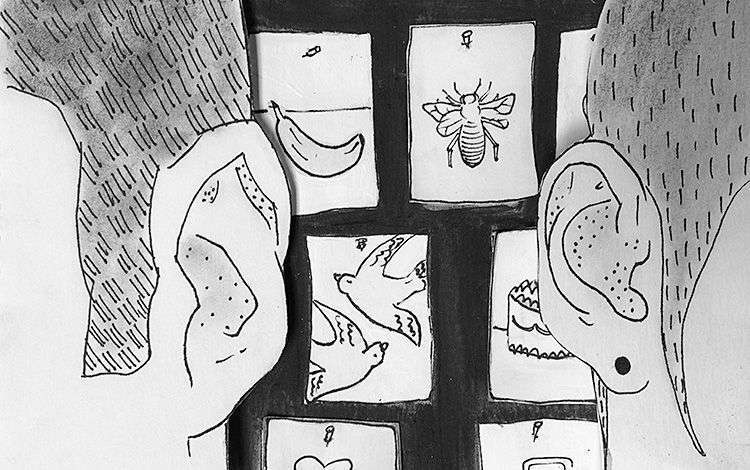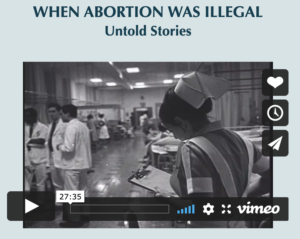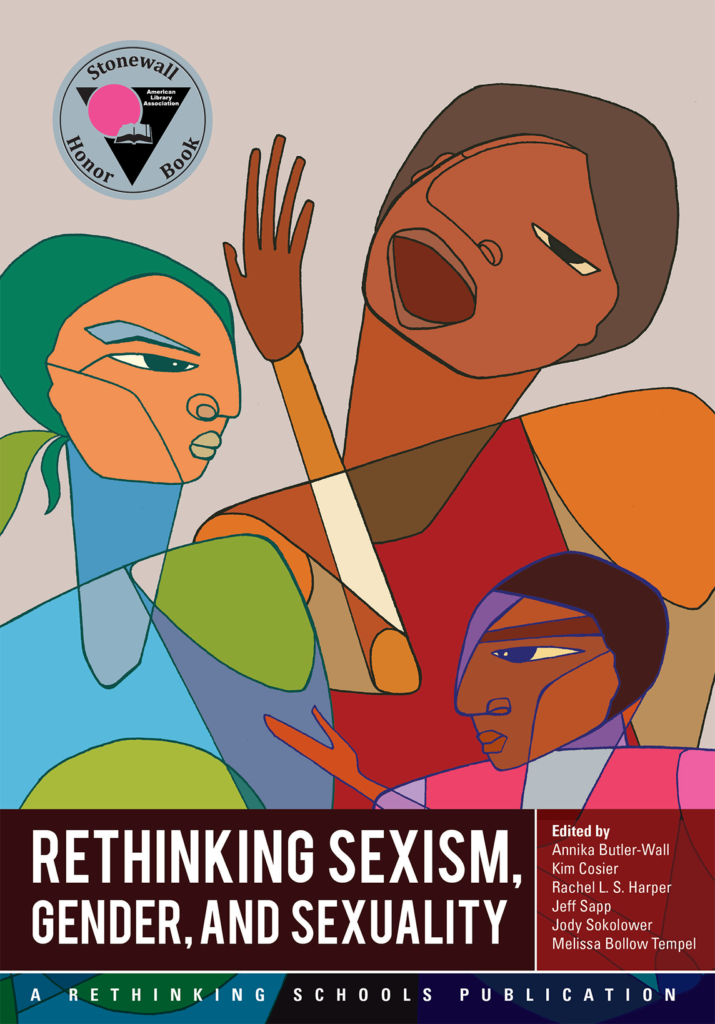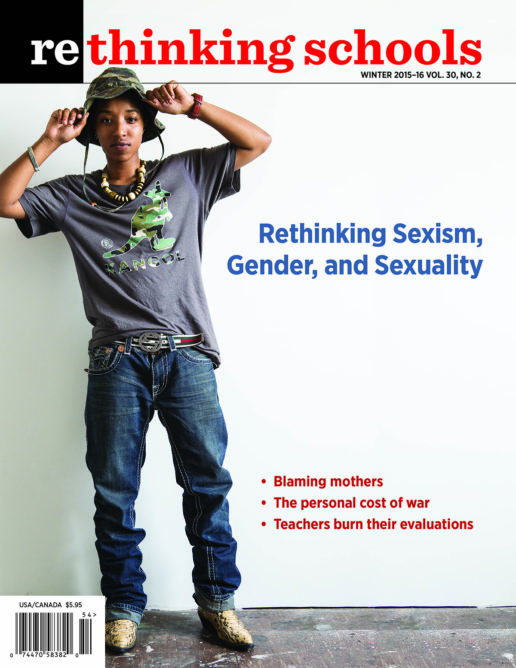Elbow Is Not a Sexy Word
Approaches to sex education
Illustrator: Alaura Seidl

“We’re going to start out today with a contest,” I told my 9th-grade students at the beginning of our unit on sex education. I put them in groups of four or five, and had each group divide a piece of paper into four large rectangles.
“I’m going to give you four words,” I explained, “one at a time. You’ll have two minutes to come up with as many synonyms—as many words that mean the same thing—as you can. They can be in English or any other language; they can be nice words or not-nice words. Anything goes. The group that comes up with the most synonyms wins. Got it?”
Once everyone was clear and each group had a scribe with pen in hand, we started.
“The first word is penis.”
After a few seconds of shocked silence and then giggles, the groups got busy. I walked around, encouraging individuals and groups that were having trouble getting past their shyness or embarrassment. “How do you say penis in Urdu?” I asked one group. “What did your family call penises when you were little?” I asked another.
At about two minutes, I told everyone to stop. “How many did you get?” I asked. “Anyone want to read their list?”
Then we moved on to the next rectangle. “Are you ready for another? The next word is breast.”
We repeated the process and then moved on to the third word: vagina.
After the groups spent two minutes on vagina, I said: “Are you ready? Here’s the last word: elbow.”
It took a little while for the students to realize how few words there are for elbow. Some groups wrote elbow in another language or two, but that was about it. One group broke into laughter as they realized they had skidded to a halt.
After finding out how many words the groups had for each square and asking for volunteers to read their lists, we moved to some broader questions. “Look at your lists,” I said. “What do you notice?”
“There are lots of words for breast, penis, and vagina, but hardly any for elbow.”
“Why do you think that is?” I asked.
“Because people like to talk about sex?”
“Because our society is kind of obsessed with that stuff?”
“Because elbows are boring!”
“A lot of the words for breast and vagina are nasty,” Sonja said. “Like put-downs of women. The words for penis aren’t like that.”
“‘Weiner’ isn’t that nice a word,” Jeremiah objected.
“No, but it doesn’t feel as bad as ‘cunt,'” Michael suggested. “Maybe it’s the way people use those words.”
“Why do you think that might be?” I asked. A few students made connections to the ideas we had discussed during our unit on sexism several months earlier.
Then I asked: “So why do you think I started our sex ed unit with this game?” We spent a few minutes teasing out the goals for the activity: to help them feel comfortable talking about sex in class, to clarify why we would be using clear but neutral terms for body parts and sexual acts, and to inject a little humor to lighten the mood.
Those aren’t far off from my goals for this article. It’s not a rounded look at our unit. It’s just a few ideas for how to approach sex education in ways that are inclusive, sex-positive, and encourage participation and growth.
Building on Community
I was teaching sex education at Berkeley High School in Berkeley, California, in the context of a yearlong Identity and Ethnic Studies class. In the fall, we had worked on building community and completed units on racism, immigration, and sexism. So the students were already experienced at discussing personal and controversial topics with each other. Supportive community is critical for sex education that will empower and enlighten. It was also important that we had explored the history and current reality of sexism (including homophobia) before we started talking about sex.
Supportive community is critical for sex education that will empower and enlighten.
I also wanted to make sure that the students were already thinking about their own values. I often taught Erik Erikson’s psychosocial stages before we started the sex education part of the curriculum. Although Erikson was homophobic and that’s reflected in his writings, I have found his description of the challenges at each life stage helpful to adolescents. I discussed each stage with the class, then had them make drawings or create written or acted vignettes to show that they understood each.
According to Erikson, the developmental challenge for teenagers is identity vs. confusion. That provided a chance for me to talk about this as a time in their lives to think about their own values as distinct from those they grew up with in family and community. I see acting consciously on your own values as central to sex ed and returned to it at many points during the unit.
I also distributed an opt-out permission slip for students to take home to their parents—according to district policy, parents could ask that their students not participate in the sex education curriculum. I never had a parent send back the form. One year a student told me he wasn’t comfortable learning about sex in a mixed-gender classroom; he and I arranged an alternative program for him on those days and he went to the library.
After the synonyms game, I laid the groundwork for the unit by teaching the anatomy and physiology of sex, starting with female bodies and then moving on to male bodies. Before we started, I briefly reviewed the difference between anatomy and gender. We were going to be reviewing sexual anatomy, which is not necessarily the same as how individuals define their gender.
I distributed blank outlines of female sexual and reproductive organs, handed out colored pencils, projected the outline onto the whiteboard, and dimmed the lights. Then, starting with the ovaries and working my way through to the clitoris, I labeled, colored, and described the function of each organ, welcoming and answering questions. Along the way, I added details that paved the way for later discussions of birth control and safer sex. I explained the menstrual cycle and its implications for fertility. I talked about routine gynecological visits and preventive healthcare. Something about the dim lights and coloring in an outline makes students more relaxed; they ask questions that wouldn’t come up in other situations.
When I got to the external sex organs, I said: “You know, guys know what their sex organs look like just by looking down. For women, it’s a little harder, but it’s something you want to know. So pick a day when you have some privacy at your home, grab a mirror, lock the door to your bedroom or bathroom, and take a look at yourself.” This was greeted by giggles and groans. “Just think about it,” I added. “We want people we’re intimate with to know, love, and respect us and our bodies. That starts with knowing, loving, and respecting ourselves.” Then I moved on. I was just planting the seed of an idea.
The next day, we did the same with male anatomy. Once again, I laid groundwork for an understanding of birth control and safer sex. For example, when we looked at the vasa deferentia, we talked about the difference between sperm and ejaculate. I explained what a vasectomy does and we talked about why that was a decision a male probably wouldn’t make until later in his reproductive life. “What questions would you ask yourself,” I said, “before you would decide to have a vasectomy? Why might you decide that was a good idea? Why might you decide it was a bad idea?”
At the end of the male anatomy lesson, I showed the segment “What Happens During Ejaculation” from Woody Allen’s 1972 movie, Everything You Always Wanted to Know About Sex (But Were Afraid to Ask). It’s a fantasy of what’s happening at “command central” during a sexual encounter. It’s funny and pretty accurate, so it makes kids laugh but also reinforces their understanding.
Journaling
I had students write almost every day in their journals to ensure that they were reflecting on what we were discussing. I wanted to stay in close touch with what they were thinking and feeling. By this point in the year, my students had lots of experience with journaling. When I first introduce journals in the fall, I explain that students can always fold a page over if they don’t want me to read a particular entry because it’s too personal. I also explain that if their journal reveals that they might be hurting or thinking about hurting themselves or others, or if they are being hurt by someone, I have to do something about it, but I’ll always talk to them first.
Here are a few examples of prompts that I used during the sex ed unit:
- When did you first learn about sex? Who told you? What did they say? What were your first reactions?
- What experience have you had with sex ed—at school, at home, elsewhere? What happened? What were your thoughts and feelings about it?
- What are the rules in your family about “going out” or dating? What rules do you agree with? What rules don’t you agree with?
- How do you think teenagers should decide whether they want to be sexually intimate with someone they like or love? What questions should they ask themselves? What should they talk about with their partner?
We usually did journal writing in the beginning of class as an opener for the day’s lesson. I would read and explain the prompt, then give students 10-15 minutes to write. If most students were still writing, I would give extra time. If students stopped writing and turned to other things after five minutes, I would repeat my standard mantra about journal writing: “When you think you’re done writing, when you put down your pen and start looking around at everyone else, twiddle your thumbs for a while, and then pick up the pen and start writing again—that’s the real journaling. The heart of journal writing is when you go deep under what’s on the surface, what you write after you think you’re done.”
After I’d given everyone a two-minute warning and asked them to finish up, I’d ask if anyone wanted to share or talk about what they’d written. I’ve almost never had a class where at least some students weren’t eager to break the ice and share what they wrote.
Talking About Sex
Berkeley has a sex education program that starts in elementary school. By the time students get to 9th grade, there are usually volunteers ready to demonstrate how a condom goes on a model penis. At the high school, there is a peer education project that operates out of the health center. Peer educators have a planned curriculum in which they show and discuss various forms of birth control and safer sex protection. That made my job much easier.
To prepare for their visit, I opened up a discussion of birth control and safer sex. “Birth control is just about pregnancy,” I explained. “Its only goal is keeping sperm from meeting up with an egg until the right time in everyone’s lives for having a baby. Safer sex, on the other hand, is about preventing the spread of sexually transmitted diseases in addition to preventing pregnancy. For example, let’s start with birth control pills. What do they do?”
“Girls take them. But if you forget, you get pregnant. That’s what happened to my cousin,” Lila said.
“That’s right. Birth control pills change the environment in the uterus so that even if an egg is fertilized it won’t nest in the uterus and begin to grow. So birth control pills, just like their name says, work as birth control. Do they work as safer sex? Do they protect you from sexually transmitted infections (STIs) like gonorrhea or HIV?”
“No,” a chorus of students responded. They explained that you need a physical barrier—a condom or a dental dam—to prevent STIs.
“What about if two males are having sex?” I asked. “What about two females?”
The next day, the peer educators had a series of games that reinforced the differences between safer sex and birth control. They had a volunteer demonstrate how to use a condom and explained how students could get condoms at the health center (which has its own sex education process). They split the students into roving small groups so they could see different kinds of birth control and ask questions. After the peer education presentation, I reviewed what we had learned and asked for questions again.
Talking about safer sex is difficult for all of us, and especially for youth.
The mechanics of safer sex and contraception are useless without communication. Talking about safer sex is difficult for all of us, and especially for youth. I wanted to make the point that communication is at the center of relationships, and that communicating about safer sex is a subset of this. So I had students do another activity. I asked them to brainstorm all the things you might want to do with someone you feel attracted to. I threw out a few ideas to get things rolling: compliment them on their clothes, text them, have oral sex, bake them a cake, hold hands. Soon students were calling out ideas from all over the room. I wrote them all on the board in no particular order. In general, I keep an eye out to make sure that our list is LGBTQ-inclusive. If students are shy to name “anal sex” or “intercourse,” I’ll say it. On the other hand, if there aren’t lots of lighter options like “going to the movies” or “kissing,” I’ll suggest those.
Once the board was covered with ideas, I counted them and wrote the number—31—on the board. I reminded students that we had used continuums frequently over the course of the year. “So what is a continuum?” I prompted.
“It’s putting things on a line from the least to the most,” someone volunteered.
“Exactly. Take a piece of paper and turn it sideways. Draw a long line all the way across the paper. Label the left end ‘least intimate’ and the right end ‘most intimate.’ Now look at all the ideas on the board. Think about how well you would need to know someone, how close you would need to feel to them, to want to do each one. Then write the ideas on the line in the order of how you feel about them in terms of intimacy. For example, for me, if I liked someone but didn’t know them very well and just wanted to flirt a little, I might say I liked their clothes. I’m going to put that first. Write the ideas sideways across the line so you have enough room to fit them all in.”
“Once you have all the ideas in order, start numbering them from left to right, No. 1 to No. 31. If there are some ideas you don’t think you would ever want to do, just leave them off. And remember, this list is just for you. We’re not going to share the lists, and you’re not going to turn them in. Just go with how you feel.”
When the students had finished putting the ideas on their continuum charts and numbering them, we debriefed. “Can someone tell me,” I asked, “what they have for No. 13?”
“Necking,” Jess volunteered.
“Did anyone else have necking for No. 13?” A few hands went up.
“Anyone want to volunteer something else they have for 13?”
“Meeting my parents.”
“Oral sex.”
“Going to the movies.”
“Could someone tell me one thing they have for one of the last three numbers?” I asked.
I was careful not to push anyone to share more than they wanted to, but soon we had amassed enough information for the students to realize how different their lists were. I said: “Wow, from what you all have volunteered, it’s clear that your continuums are really different. For example, take oral sex. For some of you, that’s something that takes a lot of intimacy. You probably wouldn’t want to have oral sex with someone until you had been in a relationship for a while and had built up a lot of trust. For other people, it’s no big deal.”
“So what does that mean? If you feel attracted to someone, how are you going to know what they want to do, and what will make them feel like running in the opposite direction?”
“I guess you have to talk them.”
“This is weird. I had no idea it would be so different.”
“Can’t you just kind of tell what a girl wants?”
I used this activity as the entry point for lots of discussion and role playing: What kind of problems could you run into if you make assumptions about what someone wants to do sexually? What constitutes “consent?” What does that look like? How does it sound? How might you talk about taking the next step? How might you talk about safer sex?
What if Your Partner Is Pregnant?
Then, I started our unit on pregnancy with a journal entry:
- Imagine that you find out that you or your partner is pregnant. What is your first reaction? How do you feel? Who would you talk with about it? Who wouldn’t you tell? What do you think you might do?
We explored the options—abortion, adoption, and raising the child—working in small groups to generate possible advantages and disadvantages for each path. In their journals and in class discussion, some students talked about the contradiction between what they have heard at church or at home—that abortion is murder—and what they actually think would be the right thing to do. I tried to create space for them to think about the difference between what their church and/or community might say, and what they might feel and need in that situation. I included quotes from a range of youth who decided to have abortions, those who are raising their children, and those who decided to have their babies placed for adoption.
The historical and political context often gets ignored in sex education classes, and this is something that I try to include in one way or another. In some classes, we have spent a week or two studying the history of reproductive rights, including the videos When Abortion Was Illegal and If These Walls Could Talk. Angela Davis’ seminal book Women, Race, & Class has an excellent section on the racist contradictions of the early reproductive health movement.
I always teach basic information about HIV/AIDS, but some years I expand that to study the history of the epidemic (watching And the Band Played On and/or Philadelphia), explore the science, research the impact of HIV/AIDS in Africa and other parts of the world, invite someone living with HIV to the class, and so on.
What Will Fly at My School?
Not every school has a health center with a program for educating students about condoms and making them available. Not every school has peer educators. In some schools, an open discussion about the advantages and disadvantages of having an abortion could get you fired.
I realize that many of these activities might have to be modified depending on the school climate. But I believe that the basic principles can be successfully adapted to many situations. The first is building a classroom community where students feel safe to explore their own developing thoughts and feelings, in journal writing and class discussions. I try to lay groundwork for an understanding of sexism and homophobia earlier in the year. That could take the form of critiquing popular culture for views on women and gay people, focusing on women’s history and/or literature, talking about recent changes in laws and popular ideas about gay marriage, and so on. I don’t want the first time I talk about sexism to be in the context of a discussion of what constitutes consent, or the first time I mention lesbians to be in the context of dental dams. Then, I think the watchwords for building a unit are: include lots of information, perspectives, and youth voice; be careful not to make judgments; and approach sexuality as part of the joy of life.
Finally, this is a fairly new and rapidly developing field. How I teach sex ed—particularly in terms of trans inclusion and not assuming a gender binary—has changed a lot in the past decade or so. So I try to keep my ears, my heart, and my mind open.
A version of this article was published in Rethinking Sexism, Gender, and Sexuality.



